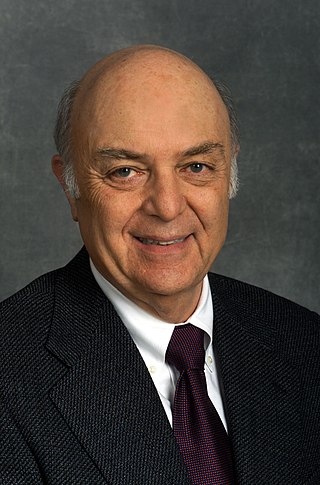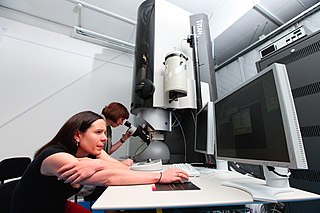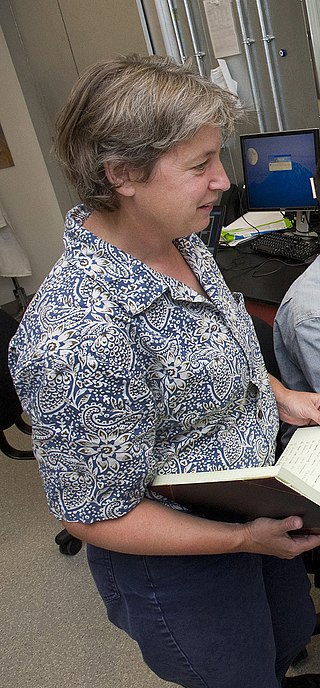Related Research Articles

A rectenna is a special type of receiving antenna that is used for converting electromagnetic energy into direct current (DC) electricity. They are used in wireless power transmission systems that transmit power by radio waves. A simple rectenna element consists of a dipole antenna with a diode connected across the dipole elements. The diode rectifies the AC induced in the antenna by the microwaves, to produce DC power, which powers a load connected across the diode. Schottky diodes are usually used because they have the lowest voltage drop and highest speed and therefore have the lowest power losses due to conduction and switching. Large rectennas consist of arrays of many power receiving elements such as dipole antennas.

A nanopore is a pore of nanometer size. It may, for example, be created by a pore-forming protein or as a hole in synthetic materials such as silicon or graphene.

Nanopore sequencing is a third generation approach used in the sequencing of biopolymers — specifically, polynucleotides in the form of DNA or RNA.

Marvin Lou Cohen is an American–Canadian theoretical physicist. He is a physics professor at the University of California, Berkeley. Cohen is a leading expert in the field of condensed matter physics. He is widely known for his seminal work on the electronic structure of solids.

Nanobatteries are fabricated batteries employing technology at the nanoscale, particles that measure less than 100 nanometers or 10−7 meters. These batteries may be nano in size or may use nanotechnology in a macro scale battery. Nanoscale batteries can be combined to function as a macrobattery such as within a nanopore battery.
The following outline is provided as an overview of and topical guide to nanotechnology:

Cornelis "Cees" Dekker is a Dutch physicist, and Distinguished University Professor at the Technical University of Delft. He is known for his research on carbon nanotubes, single-molecule biophysics, and nanobiology.

Transition-metal dichalcogenide (TMD or TMDC) monolayers are atomically thin semiconductors of the type MX2, with M a transition-metal atom (Mo, W, etc.) and X a chalcogen atom (S, Se, or Te). One layer of M atoms is sandwiched between two layers of X atoms. They are part of the large family of so-called 2D materials, named so to emphasize their extraordinary thinness. For example, a MoS2 monolayer is only 6.5 Å thick. The key feature of these materials is the interaction of large atoms in the 2D structure as compared with first-row transition-metal dichalcogenides, e.g., WTe2 exhibits anomalous giant magnetoresistance and superconductivity.
Alan T. Charlie Johnson is an American physicist, professor in physics and astronomy at the University of Pennsylvania. Johnson currently serves as the founding executive editor of AIP Advances and the co-founder of Graphene Frontiers, LLC.

Kwang Soo Kim is a South Korean professor in chemistry, an adjunct professor in physics, and the director of Center for Superfunctional Materials (CSM), of Ulsan National Institute of Science and Technology (UNIST) in South Korea. He received his B.S. and M.S. degrees in Applied Chemistry from Seoul National University and also an M.S. degree in Physics from Korea Advanced Institute of Science and Technology (KAIST) (1975). He obtained his Ph.D. degree from University of California, Berkeley (1982). His research fields include Theoretical/Computational Chemistry/Physics and Experimental Nanosciences.
Eva Yocheved Andrei is an American condensed matter physicist, a Distinguished Professor, and a Board of Governors Professor at Rutgers University. Her research focuses on emergent properties of matter arising from the collective behavior of many particles, especially low-dimensional phenomena under low temperatures and high magnetic fields.
Jean-Pierre Leburton is the Gregory E. Stillman Professor of Electrical and Computer Engineering and professor of Physics at the University of Illinois at Urbana–Champaign. He is also a full-time faculty member in the Nanoelectronics and Nanomaterials group of the Beckman Institute for Advanced Science and Technology. He is known for his work on semiconductor theory and simulation, and on nanoscale quantum devices including quantum wires, quantum dots, and quantum wells. He studies and develops nanoscale materials with potential electronic and biological applications.

Deji Akinwande is a Nigerian-American professor of Electrical and Computer Engineering with courtesy affiliation with Materials Science at the University of Texas at Austin. He was awarded the Presidential Early Career Award for Scientists and Engineers in 2016 from Barack Obama. He is a Fellow of the American Physical Society, the African Academy of Sciences, the Materials Research Society (MRS), and the IEEE.

Sarah Jane Haigh is a Professor in the School of Materials at the University of Manchester. She investigates nanomaterials using transmission electron microscopy, including two-dimensional materials such as graphene.
Pinshane Yeh Huang is an Associate Professor of Materials Science at the University of Illinois at Urbana–Champaign. She develops transmission electron microscopy to investigate two-dimensional materials. During her PhD she discovered the thinnest piece of glass in the world, which was included in the Guinness World Records. Huang was awarded the 2019 Presidential Early Career Award for Scientists and Engineers.

Frances Mary Ross is the Ellen Swallow Richards Professor in Materials Science and Engineering at Massachusetts Institute of Technology. Her work involves the use of in situ transmission electron microscopy to study nanostructure formation. In 2018 she was awarded the International Federation of Societies for Microscopy Hatsujiro Hashimoto Medal. Ross is a Fellow of the American Association for the Advancement of Science, the American Physical Society, the Microscopy Society of America and the Royal Microscopical Society,

Deblina Sarkar is an electrical engineer, and inventor. She is an assistant professor at the Massachusetts Institute of Technology (MIT) and the AT&T Career Development Chair Professor of the MIT Media Lab. Sarkar has been internationally recognized for her invention of an ultra thin quantum mechanical transistor that can be scaled to nano-sizes and used in nanoelectronic biosensors. As the principal investigator of the Nano Cybernetic Biotrek Lab at MIT, Sarkar leads a multidisciplinary team of researchers towards bridging the gap between nanotechnology and synthetic biology to build new nano-devices and life-machine interfacing technologies with which to probe and enhance biological function.
Artificial lattice is a term encompassing every atomic-scale structures designed and controlled to confine electrons onto a chosen lattice. Research has been done on multiple geometries and one of the most notable being what is called molecular graphene. Molecular graphene is a part of two-dimensional artificial lattices.

Aleksandra Radenovic is a Swiss and Croatian biophysicist. Her research focuses on the development of experimental tools to study single-molecule biophysics. She is a professor of biological engineering at the École Polytechnique Fédérale de Lausanne (EPFL) and head of the Laboratory of Nanoscale Biology.
Ursel Bangert is the Bernal Chair in Microscopy and Imaging at the University of Limerick as well as a Lecturer at the University of Manchester, of Research Fellow at Surrey University, and of PhD student at the Universität Köln. She develops advanced characterisation techniques such as transmission electron microscopy for the atomic scale imaging of novel materials. Her research outcomes include achievement of TEM imaging and electron energy loss spectroscopy on the sub-atomic scale to reveal structure and dynamics of individual atoms
References
- 1 2 3 4 "Marija Drndic | Department of Physics and Astronomy". www.physics.upenn.edu. Retrieved 2019-09-07.
- ↑ "MIT Department of Physics". web.mit.edu. Retrieved 2019-09-07.
- ↑ "Two Penn School of Medicine Professors Honored at White House for Research and Community Service – PR News". www.pennmedicine.org. Retrieved 2019-09-07.
- ↑ "Materials Research Society of Serbia - Marija Drndic, 2D Materials Nanosculpting and Bioelectronics Applications". www.mrs-serbia.org.rs. Retrieved 2019-09-07.
- ↑ Drndić, Marija (2014). "Sequencing with graphene pores". Nature Nanotechnology. 9 (10): 743. Bibcode:2014NatNa...9..743D. doi: 10.1038/nnano.2014.232 . ISSN 1748-3387. PMID 25286264.
- ↑ "Penn Researchers Control the Size of 2-D Nanopores With Light". Penn Today. Retrieved 2019-09-07.
- ↑ "Creating atomic water filters". Penn Today. Retrieved 2019-09-07.
- 1 2 "Marija Drndic: Once upon a time, there was a 2D nanopore - Carbonhagen2019". www.carbonhagen.com. Retrieved 2019-09-07.
- ↑ "Two Penn Projects Will Look at Biological Applications of New 2-D Materials". Penn Today. Retrieved 2019-09-07.
- ↑ "Penn Researchers Use Nanoscopic Pores to Investigate Protein Structure". Penn Today. Retrieved 2019-09-07.
- ↑ "Marija Drndic Inventions, Patents and Patent Applications - Justia Patents Search". patents.justia.com. Retrieved 2019-09-07.